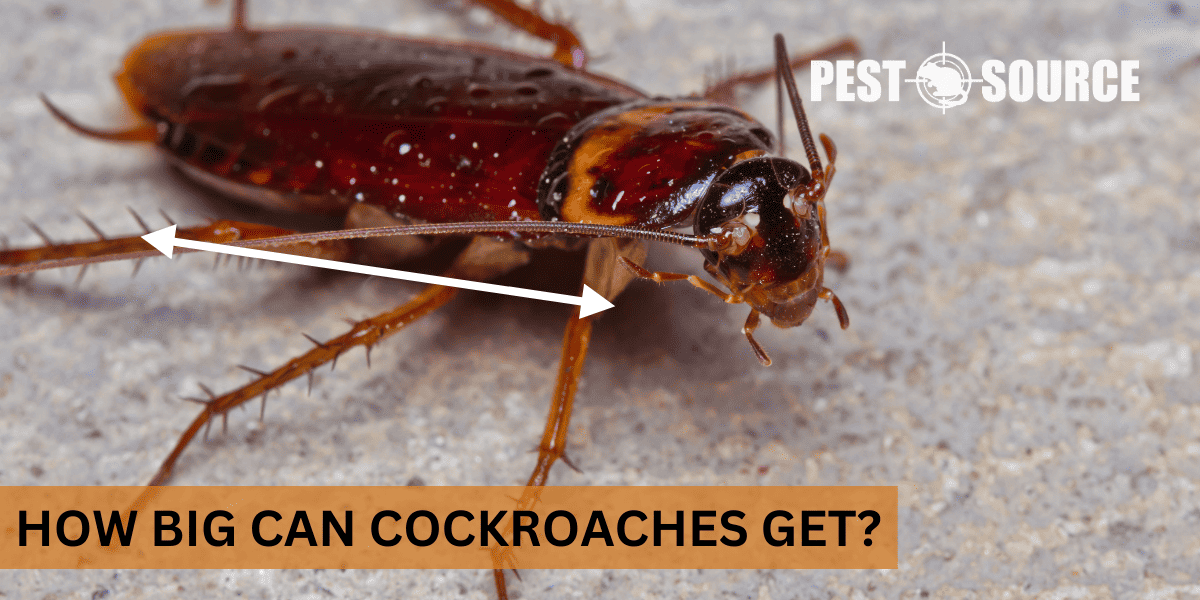The size of cockroaches varies by species, with some like the American cockroach reaching lengths of up to 3 inches. Learn about the sizes of different cockroach species in this detailed overview.
POINTS
- Cockroach sizes vary significantly by species, with some, like the giant burrowing cockroach, reaching up to 80 millimeters in length, while common household species like the German cockroach measure between 13 to 16 millimeters.
- Factors such as species, age, diet, and environmental conditions influence the size of cockroaches, and misconceptions can lead to overestimations of their size.
- Size differences within cockroach species affect their behavior and survival strategies, with larger species often being more resilient and capable of traveling longer distances.
- The Megaloblatta longipennis cockroach holds the record for the largest wingspan among cockroach species, which can reach up to 20 centimeters.
- Cockroaches are generally larger than other household pests like ants, bed bugs, and house flies, which impacts how they interact with human environments, including their hiding behavior, potential for food contamination, and disease transmission.
Maximum and Average Sizes of Cockroaches
Cockroaches are among the most adaptable and persistent pests found globally. They come in various sizes, with some species growing to surprisingly large dimensions. Understanding the size range of these insects is crucial for proper identification and management. Let’s delve into the sizes of different cockroach species, including the maximum recorded sizes and average dimensions.
Maximum Recorded Sizes for Various Cockroach Species
When it comes to the maximum sizes of cockroaches, there are exceptional cases that have caught the attention of entomologists and the public alike.
For instance, the giant burrowing cockroach (Macropanesthia rhinoceros) of Australia is considered one of the heaviest extant cockroach species, with some individuals weighing over 30 grams and measuring up to 80 millimeters in length. However, it’s the Megaloblatta longipennis that boasts an impressive wingspan of up to 20 centimeters, making it one of the largest cockroach species in terms of wingspan.
Average Size Ranges of Common Species
In a typical home setting, you’re likely to encounter species much smaller than the giants mentioned above. Here are the average sizes for some of the most common cockroaches:

American Cockroach (Periplaneta americana): This species is one of the largest commonly found in homes, with adults typically ranging from 35 to 40 millimeters in length.

German Cockroach (Blattella germanica): Much smaller than their American counterparts, adult German cockroaches usually measure between 13 to 16 millimeters.

Oriental Cockroach (Blatta orientalis): Adults of this species can be quite large, with sizes ranging from 20 to 27 millimeters.
Factors Influencing Cockroach Size
Several factors contribute to the size of a cockroach, and it’s important to understand these when trying to identify or control them:
- Species: Each cockroach species has a genetically determined size range.
- Age: Cockroaches undergo several molts as they grow from nymphs to adults, increasing in size with each stage.
- Diet: Access to abundant and nutritious food can influence the size of a cockroach.
- Environmental Conditions: Temperature, humidity, and other environmental factors can impact the growth and ultimate size of cockroaches.
- Misconceptions: Sometimes, people may overestimate the size of cockroaches due to fear or surprise upon encountering them.
Size Comparison Across Cockroach Species
The size of a cockroach can tell us a lot about its identity and behavior. By comparing the sizes of different cockroach species, we gain insight into their survival strategies and habitat preferences.
American Cockroaches and Their Size Variations
The American cockroach is a prime example of size variation within a species. Nymphs start out much smaller than adults, and as they molt, they gradually increase in size. This growth process can be influenced by the factors mentioned earlier, such as diet and environmental conditions.
Size Variations and Their Influence on Behavior and Survival
Cockroach size can affect how the insects behave and survive in their environment. Larger species, like the American cockroach, are often more capable of traveling longer distances and may be more resilient to certain control methods. Conversely, smaller species, such as the German cockroach, can hide more easily in cracks and crevices, making them harder to detect and eradicate.
Unusual Cases and Record-Holding Species
While most cockroaches you encounter will be of average size, there are some unusual cases that are worth exploring.
Documented Cases of Exceptionally Large Cockroaches
In scientific literature, there have been instances of cockroaches that exceed the typical size range for their species. These cases are often studied to understand the factors that led to such exceptional growth.
The Record-Holding Megaloblatta longipennis
The Megaloblatta longipennis holds the record for the largest wingspan among cockroach species. Found in Central and South America, this species prefers to dwell in high-elevation forest habitats and exhibits unique characteristics that distinguish it from the common household cockroach.
Reasons Behind Size Anomalies
The reasons behind the size anomalies in cockroaches can vary. Genetic factors may play a role, as well as the availability of resources in the cockroach’s habitat. Studying these anomalies can provide valuable insights into the adaptability and evolution of these persistent creatures.
Cockroaches in Perspective: Size Comparison with Common Insects
When dealing with pests, it’s helpful to put cockroaches in perspective by comparing their size to other common household insects. This comparison not only aids in identification but also helps to understand the potential impact they can have in human environments.
Comparing Cockroach Size to Other Household Insects
Cockroaches are generally larger than many other household pests. For example:
- Ants: Most common household ants range from 2 to 7 millimeters, making even the smallest cockroach species substantially larger.
- Bed Bugs: Adult bed bugs are about 5 millimeters long, which is smaller than the typical adult German cockroach.
- House Flies: An average house fly measures about 6 to 7 millimeters in length, which is less than half the size of an adult American cockroach.
This size difference means that cockroaches are more noticeable when present and can be more intimidating to people who encounter them.
The Impact of Cockroach Size on Human Environments
The size of cockroaches affects how they interact with human environments in several ways:
- Hiding and Infestation: Larger cockroaches, like American cockroaches, may be easier to spot but can also infest larger areas and hide in places where they are not easily reached.
- Access to Food: Due to their size, cockroaches can consume more food, which can lead to more significant contamination and waste.
- Disease Transmission: Larger species might be more capable of carrying and spreading pathogens due to their size and the larger areas they can traverse.



